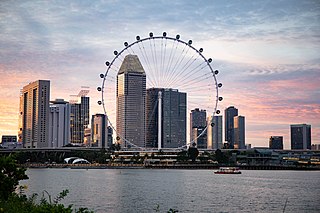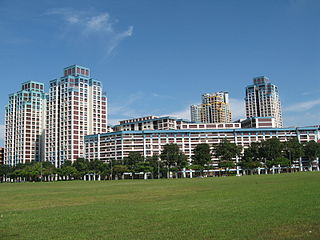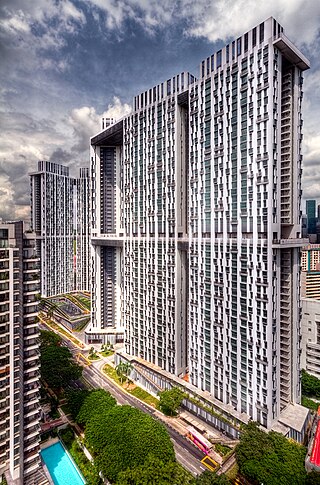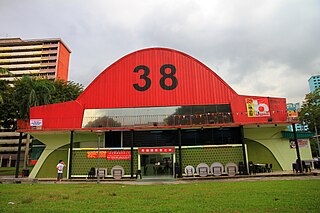
A tower block, high-rise, apartment tower, residential tower, apartment block, block of flats, or office tower is a tall building, as opposed to a low-rise building and is defined differently in terms of height depending on the jurisdiction. It is used as a residential, office building, or other functions including hotel, retail, or with multiple purposes combined. Residential high-rise buildings are also known in some varieties of English, such as British English, as tower blocks and may be referred to as MDUs, standing for multi-dwelling units. A very tall high-rise building is referred to as a skyscraper.

An apartment, flat, or unit is a self-contained housing unit that occupies part of a building, generally on a single storey. There are many names for these overall buildings. The housing tenure of apartments also varies considerably, from large-scale public housing, to owner occupancy within what is legally a condominium, to tenants renting from a private landlord.

Queenstown is a planning area and satellite residential town situated on the south-westernmost fringe of the Central Region of Singapore. It borders Bukit Timah to the north, Tanglin to the northeast, Bukit Merah to the east and southeast, as well as Clementi to the northwest and west. Its southern and southwesternmost limits are bounded by the Pandan Strait.
Tiong Bahru is a housing estate and subzone region located within Bukit Merah planning area, in the Central Region of Singapore. Tiong Bahru was constructed in the 1920s by the Singapore Improvement Trust, the predecessor to the Housing Development Board (HDB) and an entity of the British colonial authority providing mass public housing in Singapore and is the oldest housing estate in Singapore.

This article shows the notable future developments in Singapore. Most of them are currently under construction with most to be completed within the next five years.

Public housing in Singapore is subsidised, built, and managed by the Government of Singapore. Starting in the 1930s, the country's first public housing was built by the Singapore Improvement Trust (SIT) in a similar fashion to contemporaneous British public housing projects, and housing for the resettlement of squatters was built from the late 1950s. In the 1960s under the SIT's successor, the Housing and Development Board (HDB), public housing consisting of small units with basic amenities was constructed as quickly and cheaply as possible at high densities and used for resettlement schemes. From the late 1960s, housing programmes focused more on quality, public housing was built in new towns, and a scheme allowing residents to lease their flats was introduced. Throughout the 1970s and 1980s, more public housing options were provided for the middle class and efforts to increase community cohesion within housing estates were made. From the 1990s, the government began portraying public housing as an asset, introducing large-scale upgrading schemes and loosening regulations on the resale of public housing while additional housing programmes for the sandwich classes and elderly residents were introduced. Rising housing prices led to public housing being seen as an investment from the 2000s, and new technologies and eco-friendly features were incorporated into housing estates.

One-north is a subzone of Queenstown, Singapore, first developed by JTC Corporation as the country's research and development and high technology cluster. It was first conceptualised in 1991 as part of the National Technology Plan and officially launched on 4 December 2001 by then Deputy Prime Minister Tony Tan Keng Yam.

The Sentinels are two 90 metre tall residential tower blocks on Holloway Head in Birmingham, England. The two towers, called Clydesdale Tower and Cleveland Tower, are both 31 storeys tall and were part of a major regeneration and council home building scheme following World War II which in the 1960s and 1970s saw the construction of hundreds of tower blocks. Originally built and operated by the City of Birmingham, the buildings were part of a stock transfer from Birmingham local authority to Optima Community Association in 1999, and today the buildings are owned by Citizen housing association. The Sentinels were the tallest purely residential tower blocks in the city until the completion of the 102 metre tall skyscraper Bank Tower 2 in 2019. They are also surpassed by the 132 metre tall residential tower known as The Mercian located on Broad Street with 42 floors.

Pearl Bank Apartments was a high-rise private residential building on Pearl's Hill in Outram, near the Chinatown area of Singapore.

International Plaza is a high-rise commercial and residential building at 10 Anson Road in Tanjong Pagar, within the Downtown Core of Singapore, next to Tanjong Pagar MRT station on the East West line.

The new towns of Singapore are planned communities located across Singapore that are designed to be self contained. Designed to house up to 300,000 residents, these new towns contain areas zoned for housing, recreation and employment, and are composed of multiple neighbourhoods, each of which is further subdivided into multiple precincts. Amenities in these new towns are provided through a multi-tiered system, and based on Housing and Development Board (HDB) guidelines. As of 2022, the country has 24 new towns.

The Pinnacle@Duxton is a 50-storey residential development in Singapore's city center, next to the business district. All seven connected towers are collectively the world's tallest public residential buildings, and featuring the two longest sky gardens ever built on skyscrapers, at 500m each.
Treelodge@Punggol is a HDB estate located in Punggol, Singapore, located at Punggol Road, Punggol Drive and Punggol Place. It is Singapore's first experimental eco-friendly public-housing project and was awarded the Green Mark Platinum Award. The project also won international awards such as the Green Good Design Award in 2010 and the Futurac Green Leadership award in 2011 for its sustainable design.

My Queenstown Heritage Trail is a walking trail in Queenstown, Singapore. The trail was launched in 2010 by civic group, My Community, to promote the heritage, local culture and architectural styles in Queenstown.
Dakota Crescent is one of Singapore’s oldest housing estates built by Singapore Improvement Trust (SIT), the government development authority, in 1958.

Tanglin Halt is a public housing estate, planning subzone and former industrial estate in Queenstown, Singapore. Most of the older buildings in the estate are set to be demolished by 2024 to make way for redevelopments under the Selective En bloc Redevelopment Scheme. It is the third housing estate to be redeveloped under the scheme.
Selegie House is a public housing complex which includes blocks 8-10 along Selegie Road in Singapore.

Commonwealth Avenue Wet Market, also known as Queenstown Market, is a former wet market on Commonwealth Avenue in Queenstown, Singapore. It is the only remaining market designed by the Singapore Improvement Trust.
The Princess House is a building on Alexandra Road in Queenstown, Singapore. The building was initially used as the offices for the Singapore Improvement Trust, and later became the first dedicated headquarters of the trust's successor, the Housing and Development Board.

45, 48 and 49 Stirling Road are three residential flats on Stirling Road in Queenstown, Singapore. They were the first three blocks completed by the Housing and Development Board (HDB), having been previously left unfinished by its predecessor, the Singapore Improvement Trust.
















